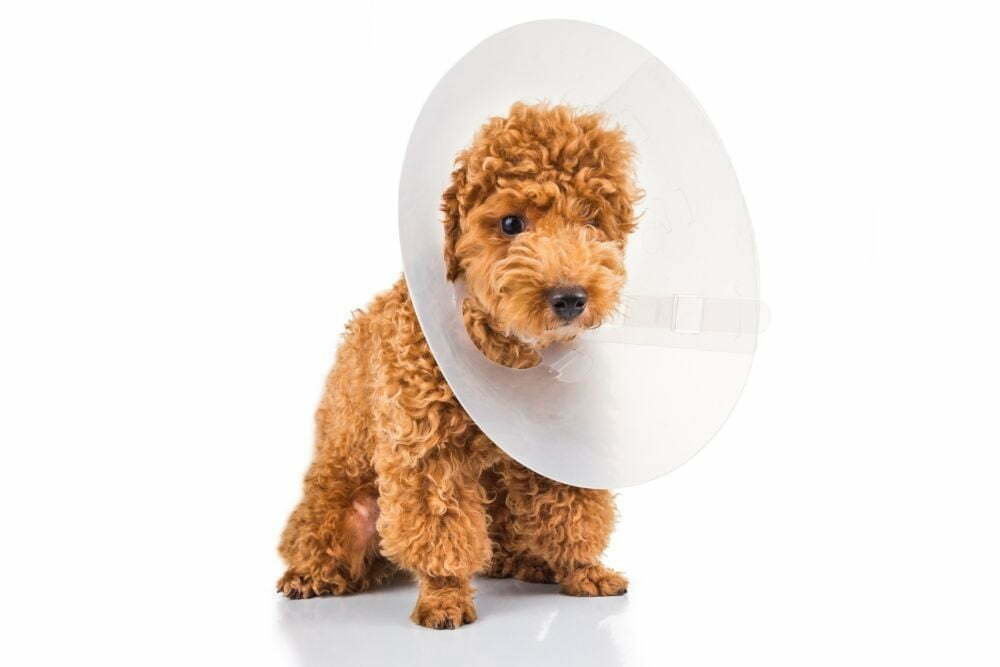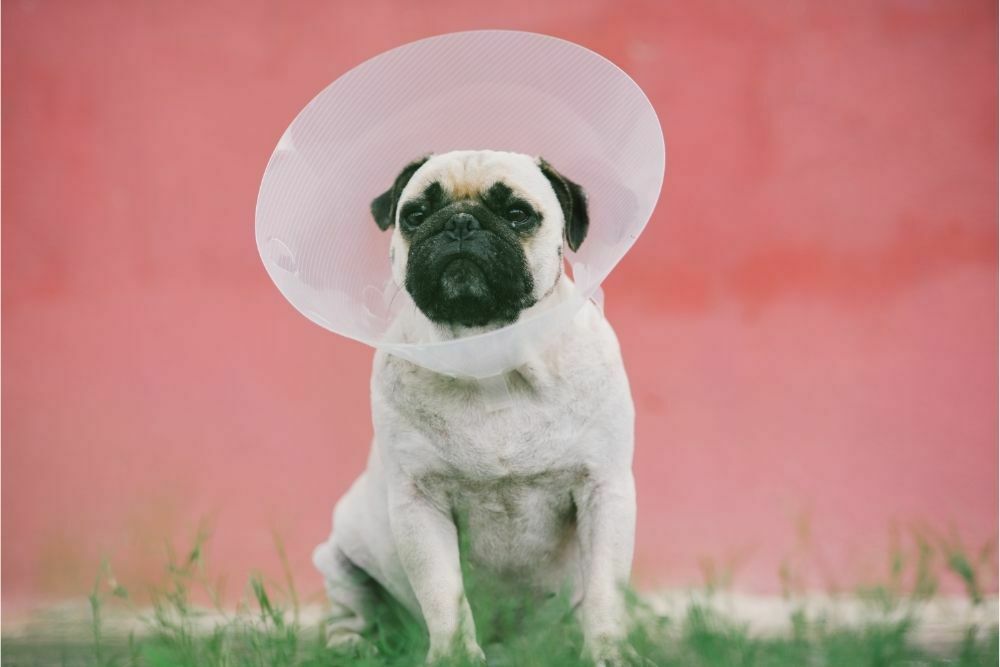If you have a dog who has recently had surgery, then they may be wearing a cone. Dogs do not like the cone of shame, and they can be very uncomfortable when wearing them.
It is highly likely that if your dog has a cone on, then they are probably spending all of their time trying to get out of it! So, most of the time, you are keeping them under constant supervision.
So, what happens when you need to leave the house or you have to go to work? Without keeping an eye on your dog, they may become stressed out by the cone or may manage to tear it off and could injure themselves. So, what are you supposed to do?

If this is the case, then you are probably wondering if you can leave your dog alone with a cone on. Luckily, we are here to help, offer you some friendly advice, and tell you exactly how to care for a dog wearing a cone.
What is a dog cone?
A dog cone is a small cone that goes around the neck to prevent your dog from licking, biting, scratching, or irritating a wound. They usually are made from plastic, such as these ones, and are typically provided to you by the veterinarian after surgery or after an incision has been made on your furry friend.
Dog cones come in all different shapes and sizes and tend to extend past the nose so that your dog physically cannot reach a wound, incision, or cut anywhere on their body. The cone shape goes around the neck so that the dog has a full range of vision, but they cannot use their mouth to touch any other part of their body.
By wearing a cone, your dog will have the best chance of healing quickly, and any wounds, cuts, or incisions are at less risk of becoming infected, opened, or torn.
Dog cones gained their name: the cone of shame due to the high number of dogs who seem bashful, embarrassed, and shamed by wearing them. Luckily, they are never permanent and are just a means to an end!
Whilst the cone protects the wound from being fussed or infected, you will be the one to protect your dog while they wear the cone.
As your dog has most likely had surgery recently, (hence the cone) you will need to keep a watchful eye on them. This begs the question: can I leave my dog alone with a cone on?
Can I leave my dog alone with a cone on?
Although you may have errands to run, or things to get on with, it is not recommended that you leave your dog alone for extended periods of time with a cone on. This is to ensure that they do not injure themselves, get stuck in a doorway somewhere, or find a way to get it off without you noticing.
If you must leave, then it is recommended that you take the dog with you, or leave with a close friend, dog sitter or family member to watch them!
Can I leave my dog home alone if they have a cone on?
The purpose of a cone is to ensure that your dog heals properly after an incision is made, or after they have had surgery. This prevents your dog from biting, scratching and licking at the wound, which could cause medical issues or an infection. This could also stop the wound from healing properly.
Whilst a cone is not painful or that uncomfortable for a dog, it can take some getting used to, and you may find that your dog will hit walls, door frames and find it hard to navigate themselves with a huge cone around their head to consider.
This is another reason that you should not leave your dog to their own devices, as they may not be used to wearing it. This means that they could use a little help from you to get through the day, eat food and drink water.
Leaving them unsupervised during this time can lead them to become prone to incidents and collisions with walls and furniture, or they may struggle to maneuver themselves through the house. They can also hurt themselves trying to get the cone off if they are left unsupervised, which can also make the healing process much longer or much worse.
It is for these reasons that you should take your dog places with you while they are confined to a cone. Try taking your dog to the store to run errands, or to work, to ensure that they are safe and comfortable while wearing the cone.
If this is not feasible, then leave your dog with a trusted friend or family member to look after them while you are out. It is not recommended that you leave your dog alone with a cone on, and we do not advise that you do so.
If, for some reason, you are forced to, then ensure that you check on them multiple times throughout the day or ask a friend or neighbor to check-in.

Can I leave a dog in a crate with a cone on?
If you usually leave your dog in a crate when you are not in the room or out of the house, then you may be wondering if you can just leave them in a crate with a cone on when you have things to do.
This is also not recommended, as the cones can be rather large and can get in the way. If your dog has a cone on and is in a small crate, then this can limit their range of motion massively, and they may be uncomfortable or unable to settle and find a nice spot to lie down.
In the worst case scenario, your dog could become stuck when they try to turn around in the crate. This can be incredibly stressful and dangerous for the dog, and you will not be there to help them out of this situation.
In any way, keeping your dog confined to a crate is not the most effective or recommended way of having a pet. Being in a crate for hours at a time can cause anxiety, claustrophobia, discomfort, and restlessness, as the dog will be cooped up all day.
How would you like to be kept in a crate for hours? This would feel ten times worse if they also had a cone on!
If you have no option but to leave your dog in a crate when you are away from home all day, then we recommend that you employ a dog walker or ask a friend or family member to come over, pet, fuss, and walk the dog.
In addition, they can feed them, play with them, let them outside to go to the toilet, and exercise with them. This will break up the day massively and will let them expel some energy instead of being locked in a crate for a while.
Dog crates can be useful for training your dog, such as these ones; just make sure that a crate is not the be-all and end-all of your dog’s life.
They need stimulation, exercise, and space to move. That being said, there are other ways of ensuring your dog’s safety while you are not in the room.
For instance, you can use stair gates or baby gates to block off certain areas of the house that are unsuitable for your dog. This will give them space to walk around and explore while you are not home! Just make sure that you keep valuables or loose items that could be damaged out of their reach.
You could also leash or tether your dog to a large, heavy object that cannot be moved and create a soft, comfortable space with blankets and toys for them to play with while you are away. This gives them freedom and space to move with a big cone on their head, but not enough that they could hurt themselves or get into trouble!
Can I let my dog sleep with a cone on?
Your dog may have to sleep with a cone on after having surgery, as it cannot be removed until after the wound is healed or after a few days have passed.
However, sleeping with a dog cone on can be very uncomfortable or difficult for some dogs. They cannot sleep in their normal curled-up position and can struggle to find a comfy spot for them to drift off in.
However, you should not remove the cone completely, as they can lick and bite the wound throughout the night without you knowing about it. Instead, you may want to create a soft, plushy, and comfortable spot for them to lie down in.
For example, you could try a donut calming dog bed or offer lots of blankets, cushions, and soft furnishings for your dog to get cozy in.
In addition, if the plastic cone that your veterinarian prescribed really seems uncomfortable, then you can purchase a softer version. We recommend the Comfy Cone, which is made of soft, padded materials to help your dog sleep soundly and safely.
On the other hand, there are inflatable options like the one below that your dog may prefer!
How long should my dog wear a cone after surgery?
How long your dog has to wear a cone after surgery depends on the specific procedure they have had. You should ask your veterinarian for any advice about how long the cone should be worn.
Typically, cones are worn until the wound has healed completely or healed enough so that your dog cannot do any damage if they scratch or bite at it.
How do I keep my dog comfortable in a cone?
As previously mentioned, dog cones can be a little uncomfortable after a while, and if not fitted properly, they can dig into your dog’s fur and neck, which can make it very hard for them to sleep.
To keep your dog comfortable and happy while wearing a cone of shame, ensure that it is fitted properly, is not moving around too much, is too loose or too tight, and digging into the fur.
If you think that the cone is ill-fitting, then seek advice from the veterinarian, who will be able to refit it.
On the other hand, you can purchase soft alternatives shown above that may benefit your dog, or you can make your own protective, comfortable cone for when your dog needs to sleep at night.
To do this, simply fold up a towel, wrap it around the neck, and tie or fasten it together with some strong tape!
If your dog seems itchy and uncomfortable when trying to sleep, then ensure that you cool down any irritation with a little water in a spray bottle, some veterinarian-recommended creams, or an ice pack.
Conclusion
To conclude, you should not leave your dog alone or unattended if they are wearing a cone after surgery. Your dog will need constant supervision, as the cone can be a lot to get used to, and they will need to recover properly.
If you are unable to watch your dog while they are in a cone, then ask a family member, friend, or dog sitter to keep your dog supervised, safe, and comfortable.

